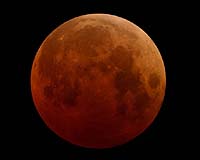 |
Paris (AFP) Dec 19, 2010 Weather permitting, skygazers in northern America and Europe are in for a treat in the early morning hours of Tuesday, when the first total lunar eclipse in almost three years is poised to turn the Moon pink, coppery or even a blood red. Coinciding eerily with the northern hemisphere's mid-winter solstice, the eclipse will happen because the Sun, the Earth and its satellite are directly aligned, and the Moon swings into the cone of shadow cast by its mother planet. The Moon does not become invisible, though, as there is still residual light that is deflected towards it by our atmosphere. Most of this refracted light is in the red part of the spectrum and as a result the Moon, seen from Earth, turns a reddish, coppery or orange hue, sometimes even brownish. "The entire event is visible from North America, Greenland and Iceland," says NASA's veteran eclipse expert Fred Espenak, pointing out that for observers in the western US and Canada, the show will start on Monday evening rather than Tuesday morning. "Western Europe will see the beginning stages of the eclipse before moonset, while western Asia will get the later stages after moonrise." The eclipse runs for three and a half hours, from 0633 GMT to 1001 GMT, although the stage of total eclipse -- when the Moon heads into the "umbra" cast by the Earth -- lasts from 0741 to 0853 GMT. Two factors affect an eclipse's colour and brightness, says the US astronomy magazine Sky & Telescope. "The first is simply how deeply the Moon goes into the umbra. The center of the umbra is much darker than its edges," it says. "The other factor is the state of Earth's atmosphere along the sunrise-sunset line. If the air is very clear, the eclipse is bright. But if a major volcanic eruption has polluted the stratosphere with thin haze, the eclipse will be dark red, ashen gray, or blood-black." Lunar eclipses have long been associated with superstitions and signs of ill omen, especially in battle. The defeat of the Persian king Darius III by Alexander the Great in the Battle of Gaugamela in 331 BC was foretold by soothsayers when the Moon turned blood-red a few days earlier. And an eclipse is credited with saving the life of Christopher Columbus and his crew when they were stranded without supplies on the coast of Jamaica. According to legend, Columbus, looking at an astronomical almanac compiled by a German mathematician, realised that a total eclipse of the Moon would occur on February 29, 1504. He called the native leaders and warned them if they did not help, he would make the Moon disappear the following night. The warning, of course, came true, prompting the terrified people to beg Columbus to restore the Moon -- which he did, in return for as much food as his men needed. He and the crew were rescued on June 29, 1504. The last total lunar eclipse took place on February 21 2008. Next year, says Espenak, will see two: on June 15 and December 10. A solar eclipse happens when the Moon swings between the Earth and the Sun. + FOR FURTHER DETAILS: - www.mreclipse.com/LEdata/TLE2010Dec21/TLE2010Dec21.html - www.space.com/spacewatch/total-lunar-eclipse-moon-101217.html - www.skyandtelescope.com/observing/highlights/111597159.html
Share This Article With Planet Earth
Related Links Mars News and Information at MarsDaily.com Lunar Dreams and more
 Total Lunar Eclipse: 'Up All Night' With NASA
Total Lunar Eclipse: 'Up All Night' With NASAGreenbelt MD (SPX) Dec 17, 2010 The December holiday sky show doesn't stop with the Geminid meteor shower - this year, the moon is also bringing a holiday gift. In the very early morning of December 21, or late night of December 20, depending on your time zone, a total lunar eclipse will make a dramatically colorful appearance - from bright orange to blood red to dark brown and perhaps gray. The next total lunar eclipse ... read more |
|
| The content herein, unless otherwise known to be public domain, are Copyright 1995-2010 - SpaceDaily. AFP and UPI Wire Stories are copyright Agence France-Presse and United Press International. ESA Portal Reports are copyright European Space Agency. All NASA sourced material is public domain. Additional copyrights may apply in whole or part to other bona fide parties. Advertising does not imply endorsement,agreement or approval of any opinions, statements or information provided by SpaceDaily on any Web page published or hosted by SpaceDaily. Privacy Statement |